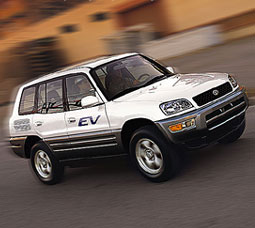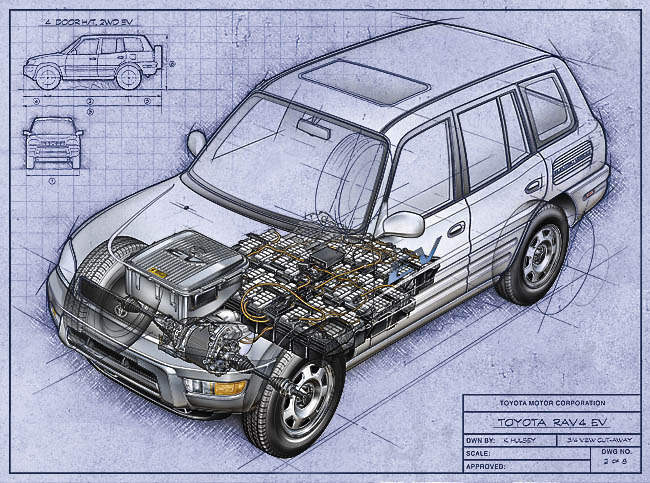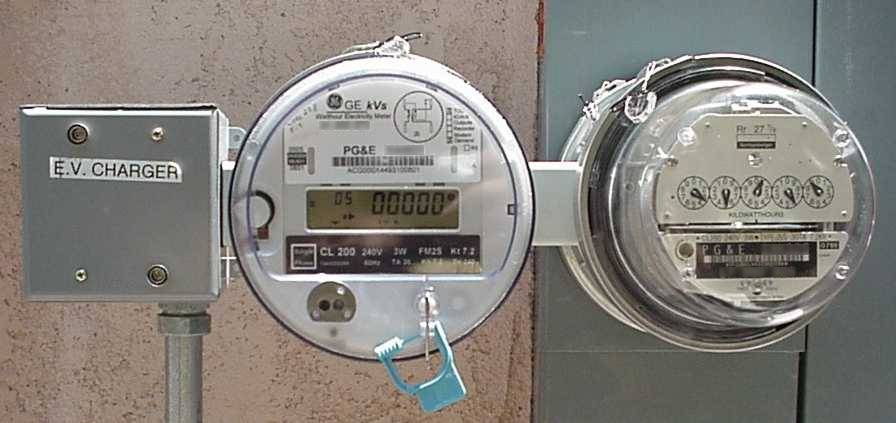
(photos courtesy Toyota)
Last modification: 01/19/08 19:26

(photos courtesy Toyota)
 The idea of owning an electric car has
always fascinated me, along with the dream of the self-sustainable house. You
can drill for water, and you can string up solar cells all day, but you can't
make your own gas. Fortunately the ways to produce electricity are many and
varied, and in California there are many plans to help subsidize your attempts
to get off the grid. But why buy an electric car? Eco-idealism doesn't cut it
for most people; certainly not Dick Cheney, who had this to say in the '2000
U.S. election:
The idea of owning an electric car has
always fascinated me, along with the dream of the self-sustainable house. You
can drill for water, and you can string up solar cells all day, but you can't
make your own gas. Fortunately the ways to produce electricity are many and
varied, and in California there are many plans to help subsidize your attempts
to get off the grid. But why buy an electric car? Eco-idealism doesn't cut it
for most people; certainly not Dick Cheney, who had this to say in the '2000
U.S. election:
"If you're one of those people who puts
solar panels on your house
or drives a battery-powered car, you might as well vote for Gore."

Not that I'm an eco-idealist; it's not enough for something (like electric cars) to be Earth-friendly, they have to be practical and affordable, and that separates most consumers from the organic granola mindset. What if you had read an ad for a car like this:
FOR SALE: Toyota RAV4EV. 150MPG. Fully loaded,
$32,000.
(Offer valid only in California.)
Read that again. For a price premium of about 50% over the gas model, you could buy a car with a per-charge price equivalent (at $3.00/gallon unleaded) of 150MPG vs. gas, made no smog, and never left home on an empty tank. And being a ZEV (zero emissions vehicle) you could drive solo in the HOV lane! Plus, when driving to places like Costco, Fry's or the airport you could help yourself to a free charge while parking... 8)
This picture is accurate, but rosy. The actual price of the car was $42,000, with $9,000 in rebates available from California over three years and (if purchased) an IRS tax incentive that helped reduce the price even more. The 150MPG comparison takes into account PG&E's E9-B rate program, which gave electric car owners a price break on off-peak electricity. The car was rated at 130 miles per charge, city (where the car's regenerative brakes & transmission help recharge the batteries.) Also, running devices like the AC, heater, or lights could impact range. Top speed was limited to 80MPH and the batteries might need replacing at 100K miles, but that's not a problem if you decide to lease. Only 339 of this 2WD model were made available by to the general public during a limited run by Toyota between 2002-2003.
After reading all of that, it's important to remember what the car didn't have. It wasn't a toy like the 3-wheeled Corbin Sparrow EV (as seen in the movie "Austin Powers"), it didn't lack any amenities, and unlike the GM EV-1, you could actually buy it. Additionally, it looked and drove like a normal car and it was easy to get repaired. If you ran out of charge, Toyota would even tow you to the closest dealer for free! All in all it seemed like a pretty good deal for consumers who were leading-edge enough to appreciate the package, but without the risks and cost of being a bleeding-edge nut.

Image © 2007 Kevin Hulsey Illustration
When the car first began shipping to consumers, (Jeez, I really need to update this - Ed.) the only feedback available was from corporate fleet buyers who participated in the model's preliminary rollout four years before. Still, that proved to be enough time to work out the bugs on a platform where the gas model had already proven itself to be one of the most road-worthy and reliable SUV's on the market. I ended up driving mine for five wonderful years, and some of my experiences follow.

PG&E E9-B meter setup (TOU is on the left)
December 19, 2002: I've been driving the car for six months now, and have gotten sufficiently comfortable with it that I can comment on things with some perspective.
The car has been completely trouble-free, reliable, smooth and quiet so far, and it's about time for its first servicing. On one occasion the car's charger (which I have set to go on at midnight, when rates are cheapest) didn't trigger, (leaving me with only half a charge the next day) and the car's had one flat thanks to a road nail. That's it! Incredible.
Design-wise, the only flaw I've experienced is a slight "shudder" at very low & reverse speeds, which has been reported by other RAV4 owners. I've also experienced an occasional exaggerated braking effect while nearing the end of the long stretch to the bottom of our mountain. I rarely experience this now that the car has been broken in, and it certainly wasn't dangerous.
Feature-wise, the car is identical to my wife's gasoline-powered 2000 RAV4 except for the heated seats, CD player and EV-specific controls (regenerative braking "EB" switch, state-of-charge "SOC" meter. etc.)
Acceleration and handling is adequate, but it's not as nimble as the gas version - and it's certainly heavier. You can feel the extra mass on windy mountain roads, but thankfully cornering is good. The low rolling-resistance tires provided aren't as grippy as the standard off-road M+S, but the weight of the traction batteries combined with an overall low center of gravity makes for pretty safe driving.
Expect 100 miles of range on a full charge with typical driving conditions. My worst-case test, which pretty much exhausts the traction batteries, is from my house in Cupertino halfway up Mt. Black (1350' altitude), across the Valley and up windy Mt. Hamilton to Lick Observatory (4170') and back. From Cupertino, I can basically make it anywhere around the Valley, be it San Mateo, SFO, Fremont or wherever, and as far south as Santa Cruz without trouble. As long as I don't need to drive to San Francisco, it's pretty much a no-brainer; I can count on the charge getting me there.
On most days, my typical commute 'n errand patterns use is about half a charge. There's been a number of times when I've simply forgotten to plug the car into the charger and still gotten around the next day. The charger itself is quite robust; I've even ran it off our 9KW house generator during the last storm, temporarily turning the RAV4EV into a... propane-charged car! Of course, when doing this there's not a lot of power left for the house...
Power-wise, the PG&E E9-B TOU plan has paid off. Electricity costs during the summer consistently ran about $1/day, typically under $35 for the whole month. It's up to you to decide which rate plan (or none at all) is best, but if you work at home and expect to keep the car awhile E9-B is the way to go.
Rebate-wise, the first $3K California Air Resource Board check came in about 6 weeks after filing for the grant, which went very smoothly. Not so smooth was the ponderous delay in getting ZEV diamond-lane exemption stickers from the DMV; these come directly from Sacramento, and only after all the paperwork has ground through the system. Expect ignorance from local DMV offices, who really aren't up to speed here.
The whole process, from ordering the car to getting your ZEV stickers has been a long one, and born out of love. It's worth it, folks; there's nothing like cruising around in a stealth mobile, with minimal road noise, no gas smell in the garage and a real good feeling. You know, the U.S. Government spent $1.5B of taxpayer money to the Big 3 U.S. Automakers to subsidize the 80MPG "Supercar" project with nothing to show for it - what a total waste. The Japanese, on the other hand, with the RAV4-EV, Honda Insight and Toyota Prius, accomplished everything we could (and should) have but didn't. When Dubya finally killed off the Supercar project, no tears were shed - would you expect anything less from a Texas oilman?

AFV Market - Late Model Environmental Vehicles For Resale
AlterNet -- So, You Want to Buy a Green Car ... Or Do You
Business Information ZEV Incentives
California's Emerging Renewables Buydown Program
CA Zero-Emission Vehicle Incentive Program (AB 2061 Lowenthal)
Electric Auto Association - Electric Vehicles and Cars
Electric Vehicle Field Operation Program
EV World The World of Electric, Hybrid & Fuel Cell Vehicles
Silicon Valley Electric Vehicle Association
Magne Charge - Small Paddle Adapters List
Pacific Gas and Electric Company - Electric Vehicles
REPP-Renewable Energey Policy Project
San Jose EAA, Electric vehicle, car, truck, bike, cycle, ev nev information
ZEVNOW.ORG - CA Zero Emission
Vehicle Alliance
Copyright © 1996-2020 Rock Island Productions